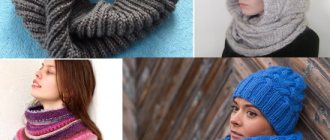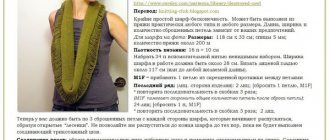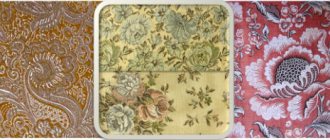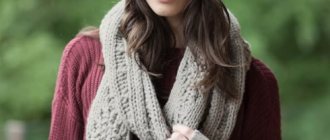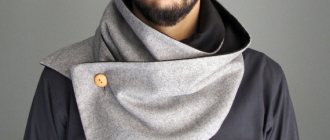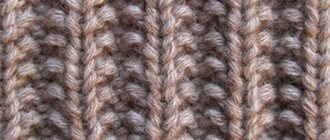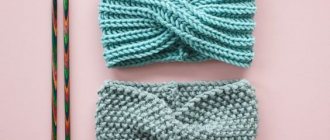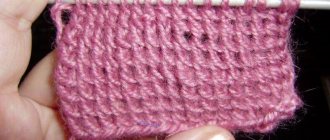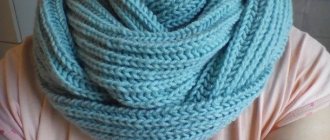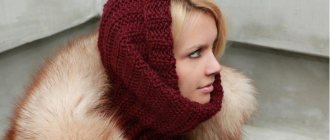What will you need for the job? Selection of tools and materials
Knitting items for men is much more difficult than for children. This is due to the conservative views of the stronger sex. Before you start knitting, you need to know the man’s preferences. The yarn may be scratchy, too fluffy, or too bright. Joint choice is the ideal solution in this case.
Advice for those who decide to surprise a man by knitting a scarf:
- For conservative men, it is better to choose muted tones: gray, steel, dark brown, black, dark green.
- If a man follows fashion and dresses in an urban style, you can choose trendy colors, combinations of voluminous knits and striped or checkered patterns.
- When purchasing, it is recommended to check the yarn for thorniness. To do this, you need to attach a skein of thread to the inner surface of the forearm or to the neck.
- It is better to opt for lint-free yarn. Patterns made from such threads are clearer.
- It is better to knit a scarf in a simple knitting pattern, focusing on the quality of the pattern.
Yarn
Threads of different compositions are suitable for knitting.
The table lists the types of yarn and their characteristics:
| Yarn type | Characteristic | Season |
| Natural (merino, angora, alpaca, cashmere) | They retain heat well, are pleasant to the touch, and do not cause skin irritation. Has the property of rolling off. | Late autumn, winter, early spring |
| Synthetic, bulk (acrylic, polyester, nylon, polyamide) | It has a pronounced thread texture, reminiscent of natural threads (cotton, wool). Poor protection from wind and does not retain heat. | Spring, autumn |
| Blended (wool with the addition of cotton, viscose, synthetic fibers) | The optimal combination for keeping warm. Synthetic fibers allow the product to maintain its appearance for a longer time, preventing pilling and shrinkage during washing. | Late autumn, winter, early spring |
| Fine wool, cotton | Keeps you warm. Fine knitting adds style to the product. | Spring, summer, early autumn |
| Thin synthetic | Allows you to create a stylish accessory and protects from bad weather. | Spring, summer, early autumn |
For beginning needlewomen, it is better to choose a bulkier yarn of mixed composition. With threads of this quality, a scarf is knitted faster and the pattern is more distinct.
Spokes
There are different types of knitting needles:
- straight;
- circular;
- hosiery;
- auxiliary;
They all have different sizes. The number of the spokes is a reflection of their diameter in mm. So, knitting needles No. 3 have a diameter of 3 mm.
To choose the right knitting needles for the yarn, you can follow these tips:
- The optimal knitting needle size is 1 mm larger than the yarn size. If the thread thickness is 2 mm, then you should choose knitting needles size No. 3.
- Circular knitting needles and long straight ones are suitable for knitting a wide product.
- Metal knitting needles work well for wool and synthetics, and wooden tools for viscose and silk.
- To create wide fabrics, knitting needles made of plastic are suitable; they are lightweight and smooth.
Other accessories
You can knit a men's scarf using knitting needles by following the step-by-step instructions given later in the article.
To work you will also need the following tools:
- scissors (to create fringe);
- crochet hook (for tying the edge with a decorative border and making fringe);
- template for pompoms;
- pins and auxiliary knitting needles (when knitting voluminous patterns).
Fashionable patterns
The choice of pattern depends on the man’s clothing style. For conservatives, a scarf knitted with an elastic band, patterns with classic checks or stripes are suitable. For daring young people - all kinds of voluminous braids, plaits, zigzags with decor in the form of fringes or tassels.
Celtic patterns in a men's scarf
Celtic ornaments are an interweaving of strands of different thicknesses, which are created from the front surface on a background of purl or pearl knitting. Motifs of Celtic weaves can be repeated in the product or combined with braids and plaits. To knit Celtic patterns, patterns are used that you can print out or create yourself. At first glance, knitting in this style seems complicated. In practice, only the skill of mastering the basic techniques of moving loops will be useful.
The main pattern of the geometry of the pattern is the symmetry of the divergence, convergence and places of interweaving of the stripes. The Celtic pattern consists of reports that are repeated along the entire height of the product.
The following combinations are suitable for a stylish scarf:
- The middle part consists of a simple Celtic braid on the reverse stitch. On the sides there are symmetrical stripes of simple braids and straight plaits.
- A canvas made entirely of Celtic weaving with a thin braid border around the edges.
- Triple alternation of a voluminous braid, framed on both sides with thin strands and a Celtic pattern of small width.
Braids, plaits and aranas
Braids, plaits and arans are part of the Irish knitting style. The pattern is created by moving the stitches to the right or left. The motifs have volume and are made in stockinette stitch against the backdrop of purl stitch or vice versa.
The braids have a vertical direction and are based on a constantly repeating intersecting motif. A simple braid is made by moving stitches to the right or left through a certain number of rows without using additional needles. When knitting wide braids, there is a need for auxiliary tools, which temporarily remove the moving loops.
The direction of twisting the braid depends on which side the loops remain on (behind the knitting or in front).
The Aran pattern is made from strands, which, in addition to interlacing, also change direction. For knitting, you can use ready-made patterns or create them yourself on a checkered piece of paper. When knitting voluminous patterns, yarn consumption increases, which must be taken into account when purchasing. Often, motifs from braids, plaits or arans are made in the center of the product. They are combined with each other or made from a simple interweaving of strands.
Shadow pattern
This is a contrasting pattern consisting of alternating knit and purl stitches. It is recommended to knit such patterns from thick, smooth threads with non-thick knitting needles. In this case, the knitting will be tight and the contrast will be clear. In a shadow pattern, you can use a combination of colors, knitting the background with one color and the pattern with another. Using this technique, you can create images of objects, animals, plants, and architecture. To create an image, cross stitch patterns are suitable.
You can knit a men's scarf using the shadow knitting technique using alternating simple geometric shapes. The scheme consists of reports that are repeated throughout the entire product. One of the current designs is a pattern of intersecting stripes.
Knitting a report consists of sequentially adding knit stitches and decreasing purl stitches. So, in the 1st row, 1 knit stitch and 4 purl loops are knitted, and in the next row (from the wrong side), 3 knit stitches and 2 purl loops are knitted with opposite loops. At the same time, from the front side, the pattern moves to the left side, creating diagonal stripes. After 8 rows, they begin knitting the report again, repeating the pattern of 1 row.
Diamonds, oblique stripes, tire tread
Creating these patterns requires some basic knitting skills. Thus, the pattern repeating the tire tread has a simple scheme. In it, the bundles diverge from the center symmetrically in different directions. The edges of the scarf are decorated with parallel wide stripes. A pattern of oblique stripes is knitted, evenly shifting the loops to the right or left side, alternating purl and knitting. In even rows, the loops are knitted according to the pattern.
A diamond pattern is created by alternating figures from knit and purl stitches. When knitting a report, the pattern of purl stitches decreases evenly on both sides, and accordingly the pattern of knit stitches increases. Having reached the middle of the diamond, the sequence changes.
Zigzag
A zigzag can be simple or complex, voluminous and colorful. In a simple version, patterns of purl or knit stitches with the same zigzag pitch alternate. The pattern of complex patterns can consist of mixing stripes of different widths and different zigzag step sizes. A variant of a pattern of 2 colors looks like a sequential alternation of a pattern of 2 rows, where the first row begins with a report (1 knit, 1 yarn over, 6 knits, knit the next 3 loops together 1 knit, 6 knits, 1 yarn over) and ends with 1 knit stitch.
In the 2nd row, knitting synchronously repeats the visible pattern. To avoid holes, yarn overs can be knitted with a crossed knit stitch. The number of loops for knitting should be a multiple of 16, 1 loop is added for the center and 2 more for the edge.
Chess pattern
It is very easy to knit a men's scarf using knitting needles, following the instructions for knitting in a checkerboard pattern. The ability to knit knit and purl stitches is enough to create an original product. The bonus of checkerboard knitting is that it is a reversible pattern that looks the same on both sides. First you need to determine the size of the squares and the number of loops in each element. Cast on a multiple number of stitches on the knitting needles, not forgetting the stitches for finishing the edge.
Knit squares, alternating knit and purl stitches. At the same time, in even (purl) rows, knit loops in accordance with the pattern.
Rice pattern
“Rice” or “pearl” is considered an excellent double-sided pattern for a scarf made with knitting needles. The design looks as if small pearls or grains of rice were carefully placed on the product. It is used for knitting scarves and hats, jackets and sweaters.
Rice pattern diagram
For the sample, cast on an even number of stitches plus 2 edge stitches.
1 r: KRM (edge), *Knit (front), PRL (purl)* - repeat from* to* until the end of the row, KRM,
2 r: KRM, *PUR, Knit* - to the end of the row, KRM.
3 r: KRM, change the loops to the opposite ones, knit PIL above the FACE and vice versa. KRM.
4 r: KRM, *Knit, PUR* - to the end of the row, KRM.
From the fifth row the pattern is repeated. Start knitting it from the first row according to the pattern.
Tips for beginners
The best thing for beginner knitters is a scarf knitted in a simple pattern. Knitting this item does not require adding or decreasing stitches, and the fabric can be knitted to any length. An important component of successful knitting is to tune in to the result and finish the scarf. Perhaps at first not everything will work out, and the drawing will not be as smooth as we would like. But the finished thing will in any case bring psychological satisfaction and the desire to continue creativity.
Knitting Tips:
- For knitting, choose thick threads with a smooth texture.
- Start with small width models.
- For the scarf, choose a pattern with a simple alternation of loops.
- Don’t complicate the work by combining colors and knitting patterns.
- Hide the free ends of the threads with a hook, pulling them between adjacent loops.
How to knit a men's scarf in garter stitch quickly and easily?
One simple technique is garter stitch knitting. This pattern is suitable for those who are just starting to knit and learning how to make the simplest loops. The advantage of this knitting is that small errors are practically invisible in the finished product.
Set of loops for knitting needles
Before typing the work, it is recommended to knit a sample measuring 10 by 10 cm and count the number of loops included in 1 cm. Knowing the desired width of the scarf in cm, multiply this number by the number of loops calculated from the sample. This way, you will get the required number of loops to knit fabric of the required width.
To knit a men's scarf with knitting needles, you first need to make a set of loops.
Make a set of loops in the classic way and start knitting.
Knitting fabric
To make a garter stitch scarf, you don't need patterns; each row is knitted in stockinette knitting. In this case, the first edge loop is removed, and the last one is knitted with a purl loop.
Knit the product of the required length and begin to complete the knitting.
Closing the loops
The loops need to be closed like this:
- The first 2 pcs. knit together with 1 knit stitch.
- Throw the resulting loop back onto the knitting needle and knit 2 stitches together again.
- Continue until 1 stitch remains on the working needle.
- Knit it, cut the yarn, leaving a free thread 10 cm long and pull it into a loop. It is easy to tighten the resulting knot.
- Hide the thread with a crochet hook, pulling it into adjacent loops.
Creating a fringe
To decorate a scarf, you can make a fringe from threads of the same tone or a contrasting color.
Fringe can be:
- dense and short, like a fur trim;
- medium length in the form of loose threads or tied in a brush;
- in the form of long threads or tassels.
Before you start making fringe, you need to determine its type and length.
For production you will need:
- cardboard;
- threads;
- scissors;
- crochet hook.
How to create a simple fringe:
- Cut a rectangle of cardboard, the width of which is equal to the length of the fringe.
- Wrap threads around the cardboard piece and cut them on one side.
- Fold the thread in half. Insert the hook into the center of the loop of the penultimate row of the fabric, starting from the right edge. Hook the center of the thread with your hook, pull it out on the other side and thread the two free ends into the resulting loop. Tighten the knot. For dense fringe, use 2 or 3 threads.
- Make fringe on 2 sides of the scarf.
- Place the product on a flat surface, straighten the threads and trim the uneven ends with scissors.
- To make brushes, you need to tie several threads into a bundle with additional thread.
Classic men's scarf knitted with elastic band
Probably the simplest and most classic pattern for a men's scarf with knitting needles is an elastic band, any one: English, French, simple.
I knitted with a 2x2 elastic band.
This scarf is made of two colors of yarn: gray and brown.
How to knit:
We cast on the required number of loops (it should be a multiple of 4 + 2 edge loops, I have only 50 loops).
1st row and all front rows: 1 edge; *2 facial; 2 purl*; 1 edge (further I will not mention edges, this goes without saying).
2nd row and purl everything: knit according to the pattern, i.e. again you get k2, p2.
Having knitted 8 cm, change the color of the thread.
In this way, we knit alternately with different yarns until the length of the scarf reaches 180 cm. Close the loops and the scarf is ready.
All that remains is to carefully hide the ends of the threads, which cannot be avoided. When connecting them, leave the ends of the threads longer so that they do not come out of the scarf later.
Ideas, patterns and step-by-step descriptions of knitting stylish men's scarves
Knitting an original men's scarf with your own hands will require knitting needles and ready-made patterns, presented later in the article.
Simple two-tone scarf with elastic band
This model looks like alternating stripes of 2 colors along the entire length of the product. The knitting method is a simple elastic band according to the 1 by 1 pattern.
To work you will need:
- yarn 2 colors;
- knitting needles of suitable size;
- crochet hook;
- scissors.
Knitting order:
- Cast on the required number of stitches, a multiple of 2, and add 2 stitches for the edge.
- The 1 by 1 rib pattern consists of alternating 1 purl and 1 knit stitch. Knit the sequence to the end of the row.
- Next knit, repeating the pattern of loops.
- Alternate yarn colors when working. Make the stripes wide, at least 15 cm. To change the yarn, you just need to start an odd row with a thread of a different color.
- Bind off the stitches by knitting stitches in pairs.
- Use a hook to hide the loose ends of the threads.
Scarf with a soft and warm double-sided pattern
The softness and warmth of a scarf directly depends on the quality of the knitting yarn. For such a product, a bulky blended thread containing at least 70% natural wool is suitable. For a three-dimensional pattern with English elastic, you will need thick knitting needles.
For a scarf 150 cm long and 40 cm wide you need approximately 350 g of yarn. To knit a scarf, you need to cast on loops on the knitting needles (their number can be read by knitting a sample) and follow the pattern of the “English elastic” pattern. The number of loops must be a multiple of 2.
Pattern diagram:
- Knit 1 knit stitch at the beginning of the 1st row. Next, repeat the sequence: 1 yarn over, slip the loop like a purl.
- In the 2nd row, re-slip 1 yarn over as a purl, knit together 1 yarn-over and 1 re-skinned loop, 1 knit stitch.
- Knit 1 yarn over and knit the next slip stitch at the beginning of the 3rd row. Make 1 yarn over and slip 1 loop like a purl.
- Knit a scarf to the desired length, alternating rows 2 and 3.
- Close knitting.
Jacquard
The jacquard technique is a combination of 2 or more colors in one fabric in the form of ornaments and designs. This technique is more difficult to perform and requires diligence and patience. To create a scarf in a jacquard style, you can choose current patterns: houndstooth, two-color zigzag, braided, honeycomb, and diamonds.
More often, the finished product is not very long. When wearing this model, it is not intended to be wrapped around the neck. The main accent of the product is the original complex pattern.
City Style
A variety of styles of men's scarves, suitable for jackets, coats and down jackets, used for everyday wear, belong to the urban style. Today, models with large volumetric knitting are relevant.
The choice of color for everyday wear depends on personal preference and style. You can knit a men's scarf using various patterns. Various braids, plaits, and complex Celtic weaves are trending. At the same time, the conciseness of a simple elastic band does not lose its relevance.
Infinity scarf
One of the urban style options is a snood scarf sewn into a ring. This option is knitted like a regular scarf, but then its ends are sewn together. You can connect the edges in the form of a Mobius strip, or you can close them in the usual way. The resulting clamp is wound around the neck in 2 or 3 turns (this depends on the length of the product).
Thick half-woolen threads are suitable for knitting the winter version. Solid and melange colors are trending. Knitting should not be complicated; simple lines look more harmonious on a twisted scarf. Infinity scarf is worn over down jackets and coats, creating a kind of high knitted collar.
Options for patterns for the collar:
- English or classic elastic band;
- voluminous braids;
- garter stitch;
- simple harnesses.
Snood with zipper
This style is more like a separate collar with a zipper. To create it, knit a rectangular piece of a comfortable length so as not to squeeze the neck. The height of the rectangle depends on whether the snood is single-layer or folded.
For ease of dressing and for the purpose of additional decoration of the product, a zipper is sewn to the ends of the rectangle. A snood scarf with a zipper can be worn under outerwear or over a jacket.
For a comfortable fit to the neck and protection from the cold, elastic patterns are often used for this style, such as elastic bands made of strips of different widths. A scarf is a simple type of product that beginning knitters begin their knitting practice with. By being creative in creating an accessory knitted from warm yarn, you can make a pleasant surprise for a man, adding charm and personality to his image.
How to knit a double-sided braid with knitting needles diagram
Not all craftswomen know about double-sided braids, which look the same on the front and back sides. Meanwhile, tying them is no more difficult than regular braids.
The only trick is that in this case the basis is not the stockinette stitch, but the elastic. This can be an elastic band alternating 2 purl and 2 knit loops or 1 purl and 1 knit loop. Larger elastic bands are not used for knitting braids.
Braids can be used as an independent pattern. But more often they are combined with other double-sided patterns. These are usually simple patterns such as Rice or garter stitch.
Knitting a double-sided braid is not difficult, and the knitting pattern looks elementary.
The basis is taken from a pattern of a regular or voluminous braid, onto which an elastic band is then applied. The only condition is that the number of loops must be completely divided by the repeat of the elastic band with which the braid will be knitted. This can be 2 or 4 loops.
The picture on the right shows a diagram of a regular braid knitted with stockinette stitch. And in the picture on the left is a diagram of a reverse braid, knitted with a 2 by 2 elastic band.

